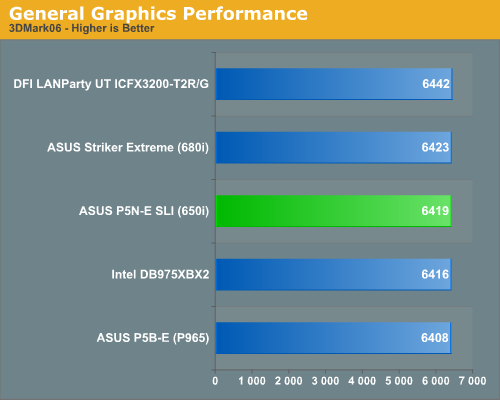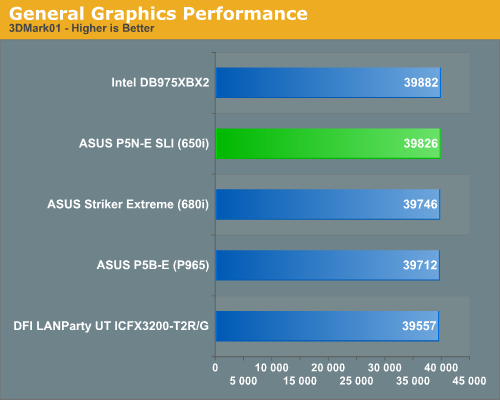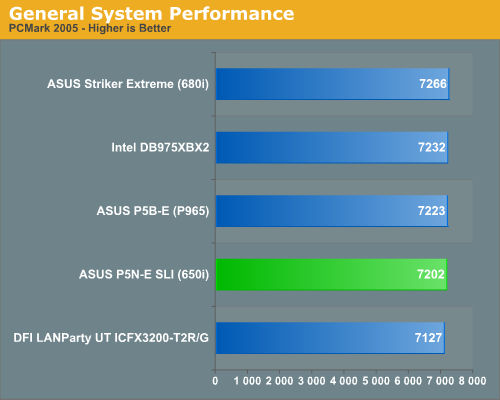ASUS P5N-E SLI: NVIDIA's 650i enters with a Bang
by Gary Key on December 22, 2006 5:00 AM EST- Posted in
- Motherboards
General Application Performance
The performance of the board in our application benchmarks was good and the board seemed a bit more responsive than the 680i, although the benchmarks were a tossup. While not directly competitive with the Intel P965 in our Nero Recode Test, we did find the board to perform consistently close in our full application benchmark test suite that includes audio/video benchmarks not listed in our preview. However, our 975X and P965 chipsets still offer the best overall performance.
In our Nero Recode test we consistently found the performance of the 680i/650i to be lacking due to disk access issues. The conversion process would consistently slow down while the disk was being accessed. The quality of the video conversion was not affected but it appears under heavy CPU usage that disk performance suffers at this time with both NVIDIA chipsets.
Synthetic Graphics Performance
The 3DMark series of benchmarks developed and provided by Futuremark are among the most widely used tools for benchmark reporting and comparisons. Although the benchmarks are very useful for providing apple to apple comparisons across a broad array of GPU and CPU configurations they are not a substitute for actual application and gaming benchmarks. In this sense we consider the 3DMark benchmarks to be purely synthetic in nature but still very valuable for providing consistent measurements of performance.


In our 3DMark06 test, each platform score is basically the same although we see the DFI RD600 based motherboard leading slightly. We attribute this slight difference to the automatic overclocking of the PCI Express graphics slot to 125MHz with our ATI X1950XT. This feature is included in the LinkBoost technology featured on the NVIDIA 680i motherboards when utilizing an approved NVIDIA graphics card. In the more memory and CPU sensitive 3DMark01 benchmark we see the Intel 975X board pulling away from the other boards due to its superior memory bandwidth at stock settings. Even though this holds true to some degree for the ASUS P5B-E based on the P965 chipset, we see it scoring slightly lower than our NVIDIA solutions due to relaxed MCH timings that allow it to excel in overclocking with FSB rates consistently hitting 520+. Although our reported Sandra memory bandwidth scores along with Memtest86 testing consistently show the RD600 performing better than the 680i or 650i, our 3D01 benchmark is not showing this advantage. NVIDIA based chipsets perform very well in graphics tests and the scores from our Intel DB975XBX2 indicate a highly tuned system.
General System Performance
The PCMark05 benchmark developed and provided by Futuremark was designed for determining overall system performance for the typical home computing user. This tool provides both system and component level benchmarking results utilizing subsets of real world applications or programs. The benchmark is useful for providing comparative results across a broad array of Graphics subsystems, CPU, Hard Disk, and Memory configurations along with multithreading results. In this sense we consider the PCMark benchmark to be both synthetic and real world in nature while providing consistency in our benchmark results.

The ASUS 650i is competitive in this benchmark although we expected slightly better performance based upon our other scores. The 650i and 680i scored very well on the single task disk benchmarks and both performed almost equally on the graphics subsystem tests where they led the field. However, our 975X and P965 chipset boards won the multitasking tests while the RD600 finished in the middle on most of the tests.
 |
| Click to enlarge |
The performance of the board in our application benchmarks was good and the board seemed a bit more responsive than the 680i, although the benchmarks were a tossup. While not directly competitive with the Intel P965 in our Nero Recode Test, we did find the board to perform consistently close in our full application benchmark test suite that includes audio/video benchmarks not listed in our preview. However, our 975X and P965 chipsets still offer the best overall performance.
In our Nero Recode test we consistently found the performance of the 680i/650i to be lacking due to disk access issues. The conversion process would consistently slow down while the disk was being accessed. The quality of the video conversion was not affected but it appears under heavy CPU usage that disk performance suffers at this time with both NVIDIA chipsets.
Synthetic Graphics Performance
The 3DMark series of benchmarks developed and provided by Futuremark are among the most widely used tools for benchmark reporting and comparisons. Although the benchmarks are very useful for providing apple to apple comparisons across a broad array of GPU and CPU configurations they are not a substitute for actual application and gaming benchmarks. In this sense we consider the 3DMark benchmarks to be purely synthetic in nature but still very valuable for providing consistent measurements of performance.


In our 3DMark06 test, each platform score is basically the same although we see the DFI RD600 based motherboard leading slightly. We attribute this slight difference to the automatic overclocking of the PCI Express graphics slot to 125MHz with our ATI X1950XT. This feature is included in the LinkBoost technology featured on the NVIDIA 680i motherboards when utilizing an approved NVIDIA graphics card. In the more memory and CPU sensitive 3DMark01 benchmark we see the Intel 975X board pulling away from the other boards due to its superior memory bandwidth at stock settings. Even though this holds true to some degree for the ASUS P5B-E based on the P965 chipset, we see it scoring slightly lower than our NVIDIA solutions due to relaxed MCH timings that allow it to excel in overclocking with FSB rates consistently hitting 520+. Although our reported Sandra memory bandwidth scores along with Memtest86 testing consistently show the RD600 performing better than the 680i or 650i, our 3D01 benchmark is not showing this advantage. NVIDIA based chipsets perform very well in graphics tests and the scores from our Intel DB975XBX2 indicate a highly tuned system.
General System Performance
The PCMark05 benchmark developed and provided by Futuremark was designed for determining overall system performance for the typical home computing user. This tool provides both system and component level benchmarking results utilizing subsets of real world applications or programs. The benchmark is useful for providing comparative results across a broad array of Graphics subsystems, CPU, Hard Disk, and Memory configurations along with multithreading results. In this sense we consider the PCMark benchmark to be both synthetic and real world in nature while providing consistency in our benchmark results.

The ASUS 650i is competitive in this benchmark although we expected slightly better performance based upon our other scores. The 650i and 680i scored very well on the single task disk benchmarks and both performed almost equally on the graphics subsystem tests where they led the field. However, our 975X and P965 chipset boards won the multitasking tests while the RD600 finished in the middle on most of the tests.










27 Comments
View All Comments
Thats Me - Tuesday, March 6, 2007 - link
I currently have an Intel D945Gnt motherboard that has proven to be a looser in various ways. Using an Intel Dual-Core 3.2 Ghz processor, 2x512 Mb dual channel RAM. Am considering change to the Asus P5N-E motherboard so need advice--will my existing CPU work Ok in the Asus?HELP!
jdrom17 - Tuesday, January 23, 2007 - link
Just wondering if you are going to update the review, as ASUS released a new BIOS version yesterday (Jan 22) which says it fixes memory compatibility.It may solve the issues you ran into, and I'd like to know if it does.
MikeeeE18 - Tuesday, January 9, 2007 - link
I read some of the reviews over here and it was a big help in oc my E6600 on the p5n-e. Currently im runin it at 3.21ghz, but my mem timings are wack. Im kinda new to this so any help would be appreciated. I have the system set to 1425 fsb (qdr) x 9 (multiplier) using pc5300 mem 2gb pqi and evga 7950gt ko. I tried setting the fsb to 1608 like it says in one of the reviews but it overloaded the system. Hoping to get some results out of this so i can make this thing a bit faster. Thanks.Operandi - Tuesday, January 2, 2007 - link
Nice review, bonus points for the fan control information.Lord Evermore - Monday, December 25, 2006 - link
Testing? But that would delay getting the product out to market before the competition, and possibly stuff up their overly enthusiastic deadlines and announcements. Not to mention costing money that they could save to let the customers beta test it. The people buying these things are tweakers anyway.
Hey, the software industry gets away with releasing shoddy, half-finished products all the time, and in fact gets the same people to keep buying them. Not to mention releasing essentially the same product with a slightly different name (nF5/nF6).
PoorBoy - Saturday, December 23, 2006 - link
I would like to know where you are setting this FSB to 402X9 (Exactly what are you setting to 402 ?)or other FSB# Settings. I just received 2 of theses Boards and Compared to a Gigabyte DQ6 or ASUS P5W DH Board which I have also I'm at a complete loss with this Board. So far no where in the BIOS do I see where I can make this change, I've been in all the Sections & Sub Sections of the BIOS but have yet to find where to change the FSB ... ???Gary Key - Monday, December 25, 2006 - link
Go into the BIOS -Enter the Advanced Section -
Change AI Tuning to Manual -
Go to FSB & Memory Config -
Changed Linked mode to Unlinked, feel free to change the FSB (QDR) rates. In this BIOS, 402FSB will be set as a 1608 (QDR) in this field.
I beleive section 2.24 of the manual has further details if my memory serves me. I just arrived at the airport and will be offline for a week in a few moments. ;-)
PoorBoy - Monday, December 25, 2006 - link
Thanks for the Tip Gary, that's what I figured I had to do. The only problem is the FSB (QDR) only allows me to set the FSB between 533 & 3000. That's not going to work for me, even @ 533 with a 9 Multiplier that's way to high a CPU Clocks speed for the system to run.I tried backing off the Multiplier to 6 and going with 533 which should be about 3.2Ghz & about where I want to run the PC. The PC booted up but was only showing me a 1.59Ghz for the CPU ... ??? I'm starting to dislike this MB immensely, sometimes more is not better IMO...All the different Options, Linked, Unlinked, AUTO, Manual, I guess is something for the Die Hard OClockers but for somebody like me who just wants to go in the BIOS & set the FSB & Voltage without all the Head Scratching on what the different Options are this isn't a good board for them.
I would return the boards but the policy where I got them is for replacement only for defective boards so I may have to just eat them & get something else that I'm familiar with. I do have 4 E6600's running on different boards @ 3.5-3.6Ghz with no problems & a X6800EE running @ 3.8Ghz also with no problems. Live and learn I guess ... Thanks again ... Steve
Marlowe - Saturday, December 23, 2006 - link
It would be very interesting if you could test the 8800GTX SLI setup in high resolution in several games that are known for acctually benefiting from SLI! So we can see how the performance difference is between the 2x16x on the 680i and the 2x8x on the 650i :-) Maby having 2x16x pci-e is more "placebo" than really important for perfomance? ;-)I also think it's interesting that there are no s775 motherboard chipset with 2x16x pci-e lanes. Both the 975X and RD600 offers "just" 2x8x pci-e if I am correct. Only the RD580 chipset for s939 and AM2 have the 2x16x pci-e feature. I wonder how the upcoming R600 cards will perform on these different platforms, how they also in Crossfire perform on the two different "speed grades" of motherboards :-) I wonder if ATI/AMD will come with a s775 chipset with true 2x16x pci-e for the release of R600 :-)
semo - Sunday, December 24, 2006 - link
yeah me too. i remember there were discussions about the pci-e transition because apparently the agp interface was quite sufficient for the traffic gf cards generated back then. i think it's also because the agp interface was not so reliable when approaching its limits but i'm really not too sure about that.anyway, it's interesting to know whether today's gf cards make benefit of the higher digital bandwidth